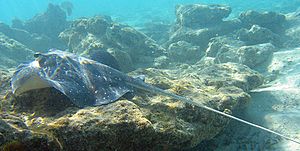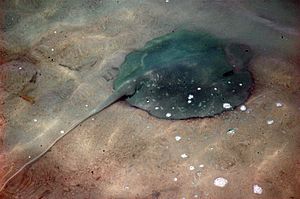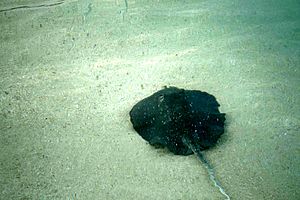Mangrove whipray facts for kids
Quick facts for kids Mangrove whipray |
|
|---|---|
 |
|
| Conservation status | |
| Scientific classification | |
| Genus: |
Urogymnus
|
| Species: |
granulatus
|
 |
|
| Range of the mangrove whipray | |
| Synonyms | |
|
|
The mangrove whipray (Urogymnus granulatus), also called the whitetail stingray, is a type of stingray. It lives in the warm waters of the Indo-Pacific region. You can find it from the Red Sea all the way to northern Australia and Micronesia. These rays live on the ocean floor in shallow areas near the coast. Young mangrove whiprays like to hang out in mangrove forests and river mouths. Older rays prefer sandy or rocky spots in lagoons and on coral reefs.
This ray is easy to spot because of its thick, oval-shaped body. It's dark gray on top with lots of small white spots. Its tail is quite short and looks like a whip. The part of the tail past its stinging spine is bright white. The mangrove whipray can grow to be about 1.4 meters (4.6 feet) wide!
Mangrove whiprays usually live alone. They mostly eat small fish and other creatures that live on the ocean floor. Like other stingrays, the females give birth to live young. The baby rays grow inside their mother and get food from a special "uterine milk." People catch mangrove whiprays for their meat and skin in many places. The International Union for Conservation of Nature (IUCN) says this ray is Vulnerable worldwide. In Southeast Asia, it's even Endangered. This is because of too much fishing and the destruction of their mangrove forest homes.
Contents
What Does the Mangrove Whipray Look Like?
The mangrove whipray has a very thick, oval-shaped body. It's almost as wide as it is long. Its eyes are medium-sized and spaced far apart. Right behind the eyes are two small holes called spiracles. These help the ray breathe.
Its mouth is on the underside of its body. It has many rows of small teeth, like a bumpy pavement. Underneath the body, there are five pairs of gill slits. These help the ray take oxygen from the water. The fins on its belly are small and narrow.
The tail of this ray is thick at its base. It can be 1.5 to 2 times longer than the body. It usually has one or two sharp, stinging spines on the top, near the base of the tail. After the sting, the tail becomes very thin and whip-like. It doesn't have any fins on this part.
The top of the ray's body and tail feel rough. This is because they are covered in tiny, tooth-like scales called dermal denticles. There are also one or two rows of thorns along its back, from its head to its sting. The mangrove whipray is dark brown or gray on top. It has many white dots and flecks. These white spots become more noticeable as the ray gets bigger. The underside of the ray is white, with small dark spots near the edges. The tail suddenly turns white after the sting. These rays can grow to be 1.4 meters (4.6 feet) wide and over 3.5 meters (11.5 feet) long!
Where Does the Mangrove Whipray Live?
The mangrove whipray is not very common, but it lives in many places across the Indo-Pacific region. You can find it in the Red Sea, parts of South Asia (like the Maldives), the Gulf of Thailand, and around New Guinea and northern Australia. It also lives near islands like Guam, Fiji, and the Solomon Islands.
This ray lives on the bottom of the ocean. It usually stays in shallow water close to the shore. However, adult rays have been seen in deeper waters, up to about 85 meters (279 feet) deep. Young rays love to live in brackish water areas. These are places where fresh river water mixes with salty ocean water, like in mangrove forests and river mouths. Adult rays prefer areas with sand, rocky rubble, or hard bottoms. They are often found in lagoons or on coral reefs.
Life and Habits
Unlike many other rays, the mangrove whipray usually lives alone. It's not very active during the day. You might find it resting, sometimes half-buried in the sand or on top of coral. At night, it becomes active and searches for food.
These rays have a special sense called electroreception. They can detect tiny electrical signals given off by other animals. This helps them find prey that might be hidden under the sand. Young rays mainly eat small crustaceans, like prawns and crabs. Adult rays eat small fish that live on the bottom, such as rabbitfishes, gobies, blennies, wrasses, and damselfishes. They also eat other invertebrates like peanut worms, crabs, octopuses, and bivalves (like clams).
Reproduction and Life Cycle
Like all stingrays, the mangrove whipray gives birth to live young. This is called aplacental viviparity. The baby rays grow inside their mother. They are fed by a special, nutrient-rich liquid called "uterine milk" that the mother produces.
When they are born, baby mangrove whiprays are about 14 to 28 centimeters (5.5 to 11 inches) wide. Male rays become ready to have their own babies when they are about 55 to 65 centimeters (21.5 to 25.5 inches) wide.
Protecting the Mangrove Whipray
The mangrove whipray can sting humans with its venomous tail if it feels threatened. People sometimes catch these rays in fishing nets. They are sold for their meat, their tough skin (called shagreen), and their cartilage.
Because these rays live close to shore, they are very sensitive to fishing. Many small-scale and commercial fisheries operate in their habitat. In Southeast Asia, the number of mangrove whiprays has dropped a lot. This is because young rays are often caught by fishers. Also, their homes in the mangrove forests are being destroyed.
In the Arafura Sea, the number of these rays has also gone down. This is due to a large Indonesian fishery that uses gillnets. These nets catch many rays by accident. Because of these problems, the International Union for Conservation of Nature (IUCN) has listed the mangrove whipray as Endangered in Southeast Asia.
However, off northern Australia, the ray is not as threatened. Fishing boats there use special devices called Turtle Exclusion Devices (TEDs). These devices help larger animals like rays and turtles escape the nets. So, the IUCN considers the Australian population to be of Least Concern. Globally, the mangrove whipray is listed as Vulnerable. This means it needs our help to survive.
Images for kids







